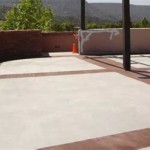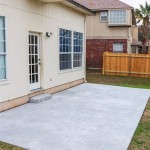Laying Pavers on a Concrete Patio: A Comprehensive Guide
Transforming a concrete patio into a stylish and functional outdoor space with pavers is a rewarding endeavor that requires meticulous planning and execution. Here are the essential aspects to consider for a successful project.
1. Patio Preparation
Before laying pavers, the concrete patio surface must be properly prepared. Ensure it is clean, level, and free of any cracks or debris. If necessary, repair any imperfections to create a solid base for the pavers. A thin layer of bedding sand or mortar can be spread over the concrete to provide a cushioning layer and improve drainage.
2. Paver Selection
Choose pavers that complement the overall design of your patio and withstand the elements. Consider factors such as durability, color, texture, and size. Pavers are available in various materials, including natural stone, concrete, and porcelain, each offering unique aesthetic and practical advantages.
3. Setting the Pavers
Lay the pavers according to the desired pattern and spacing. Mark guidelines to ensure straight lines and even spacing. Use a rubber mallet or paver tamper to gently tap the pavers into place, creating a level surface. Avoid overcrowding the pavers to allow for proper drainage.
4. Edging and Restraints
Install edging around the perimeter of the patio to retain the pavers and prevent them from shifting. Edging materials can include stones, bricks, or concrete pavers. They provide a clean and finished look while preventing the edges of the patio from crumbling.
5. Compacting and Sanding
After laying the pavers, compact the surface using a plate compactor or a heavy roller. This process ensures the pavers are firmly set and reduces the risk of settling or shifting. Sweep fine sand over the pavers and use a broom to work it into the joints, filling any gaps and stabilizing the surface.
6. Sealing (Optional)
Applying a sealant to the pavers can enhance their durability, protect them from stains, and make maintenance easier. Choose a sealant specifically designed for outdoor pavers and follow the manufacturer's instructions for proper application. Sealing the pavers helps preserve their color and prevent premature fading or wear.
7. Maintenance
Regular maintenance is crucial to keep your paver patio looking its best. Sweep or hose down the surface to remove dirt and debris. Periodically check for loose pavers and reset them if necessary. Sealing the pavers every few years helps protect them from the elements and prolong their lifespan.

How To Install Patio Pavers Over An Existing Concrete Slab

How To Install Patio Pavers Over An Existing Concrete Slab

Pros And Cons Of Putting Pavers Over Concrete

How To Install Patio Pavers Over An Existing Concrete Slab

Why Installing Pavers Over Concrete Is A Bad Idea Pavertime

Installing Pavers Over A Concrete Patio

How To Cover A Concrete Patio With Pavers Diy Family Handyman

How To Install Concrete Pavers Rcp Block Brick

How To Cover A Concrete Patio With Pavers Diy Family Handyman

Installing Pavers On Concrete Unilock








